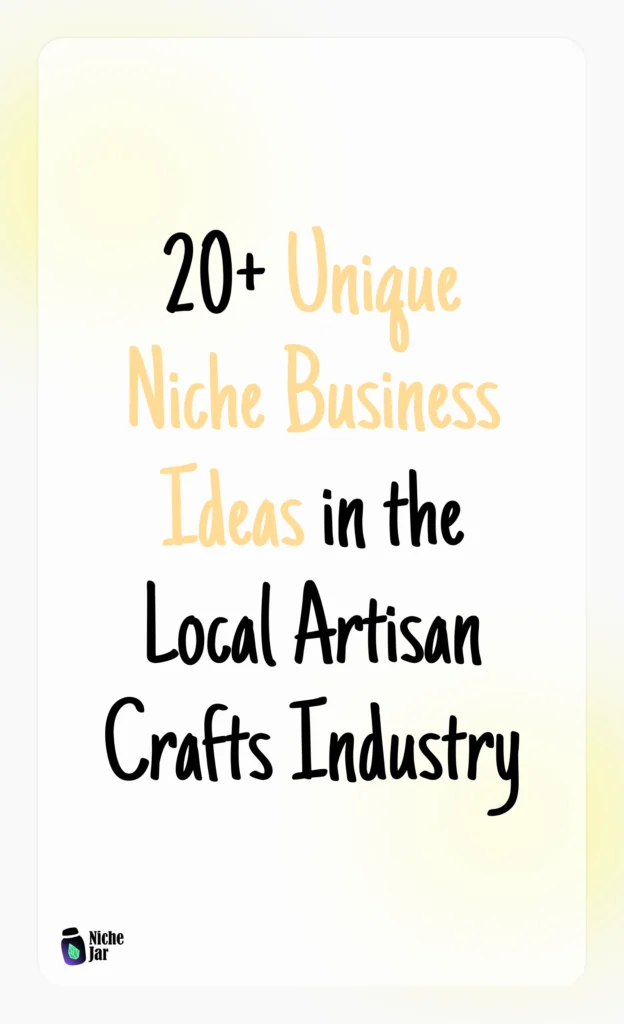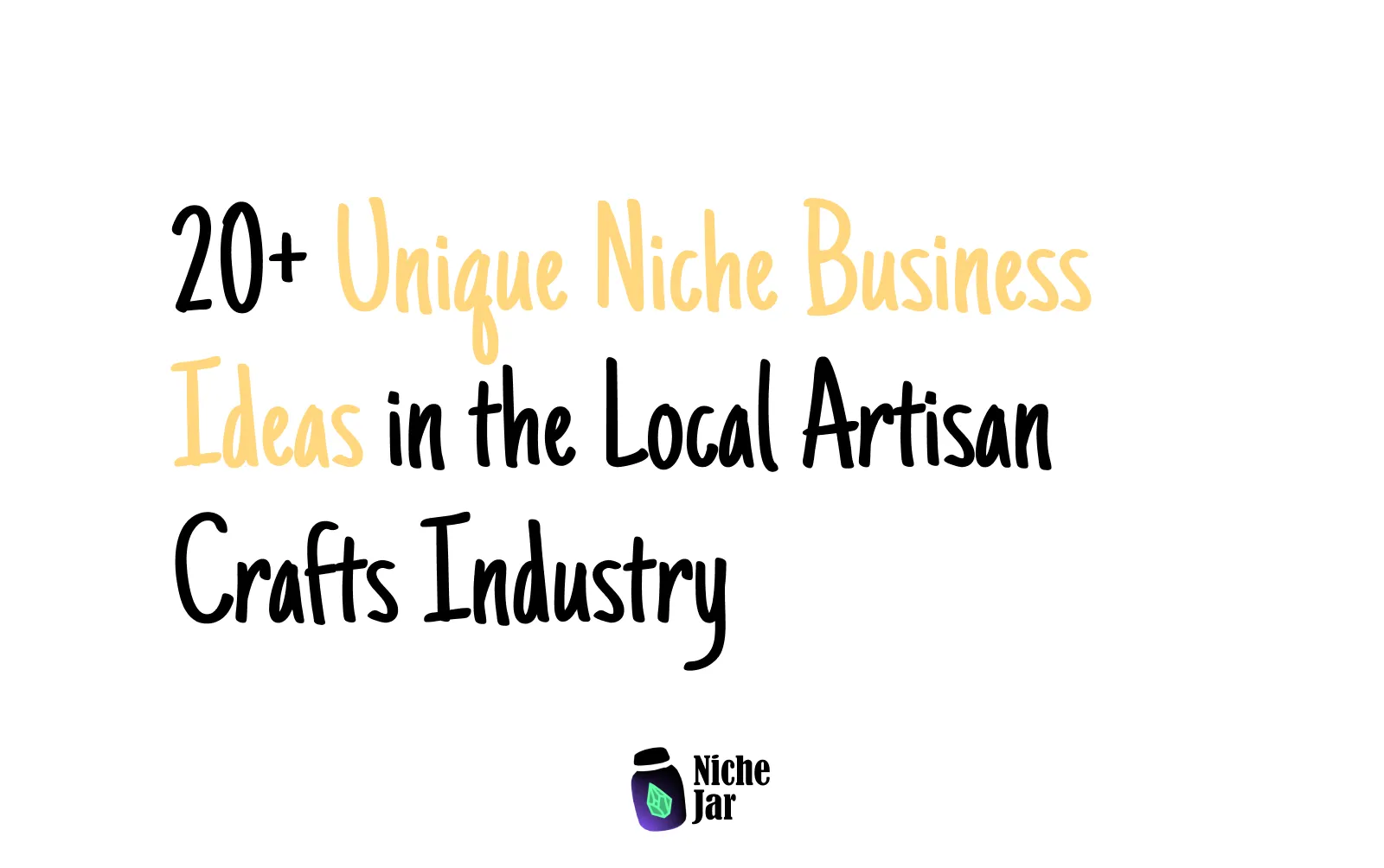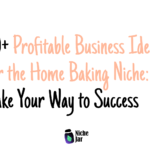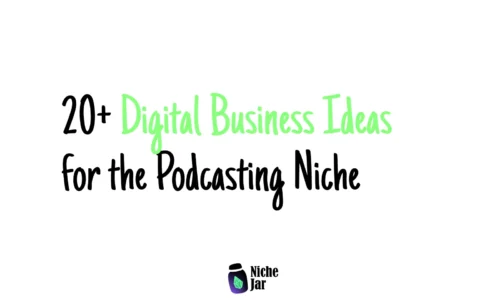- Senia
- 0 Comments
- 636 Views
Have you ever wondered if your love for handmade items could turn into a profitable business? The local artisan crafts industry is full of unique opportunities for people who want to create, share, and sell meaningful products. From what I’ve seen, even small ideas can grow into thriving businesses when nurtured with care. In this post, we’ll explore 20+ unique niche business ideas in the local artisan crafts industry that could help you earn money while doing something you truly enjoy.
he beauty of the artisan crafts industry is that it blends creativity with entrepreneurship. Unlike mass-produced goods, artisan products carry a story, a personal touch, and a sense of authenticity that many people are willing to pay extra for. In today’s world, where consumers are searching for connection and uniqueness, there’s never been a better time to explore profitable niches in local crafts.
I believe this niche matters because it gives everyday people a way to make money while honoring tradition, skill, and creativity. Whether you’re a hobbyist who loves weekend projects or someone looking to build a full-time business, there are countless paths to explore. From wood carving to handmade soaps, each craft carries potential if matched with the right audience and strategy.
This post will walk through 20+ niche business ideas in artisan crafts. For each, we’ll look at:
- Why the idea works and who it serves
- Practical steps to start
- Potential challenges and solutions
- Startup costs and monetization strategies
- Humble examples of people who’ve tried it
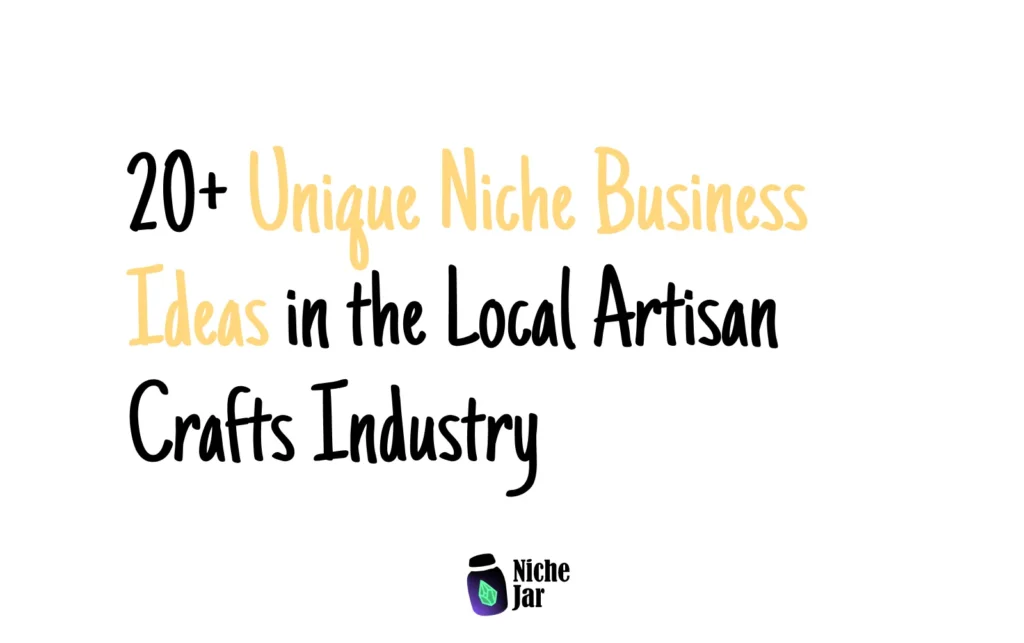
1. Handmade Jewelry Business
Handmade jewelry is one of the most profitable artisan niches because it combines beauty, personal expression, and relatively low startup costs.
Why it works: Jewelry never goes out of demand. With the rise of platforms like Etsy, Shopify, and Instagram, small creators can reach global audiences.
Steps to start:
- Choose your materials (beads, silver, clay, resin).
- Invest in simple tools (pliers, molds, wires).
- Create 10–20 sample pieces.
- Open an Etsy shop or join local craft fairs.
- Market through Instagram reels showing the making process.
Challenges & solutions:
- Challenge: High competition.
- Solution: Focus on a niche like “eco-friendly resin jewelry” or “cultural-inspired earrings.”
Startup costs: $200–$1,000 depending on materials.
Monetization: Product sales, workshops, affiliate links for craft tools.
Case example: A local artist started with clay earrings at weekend markets. Within two years, she was wholesaling to boutiques.
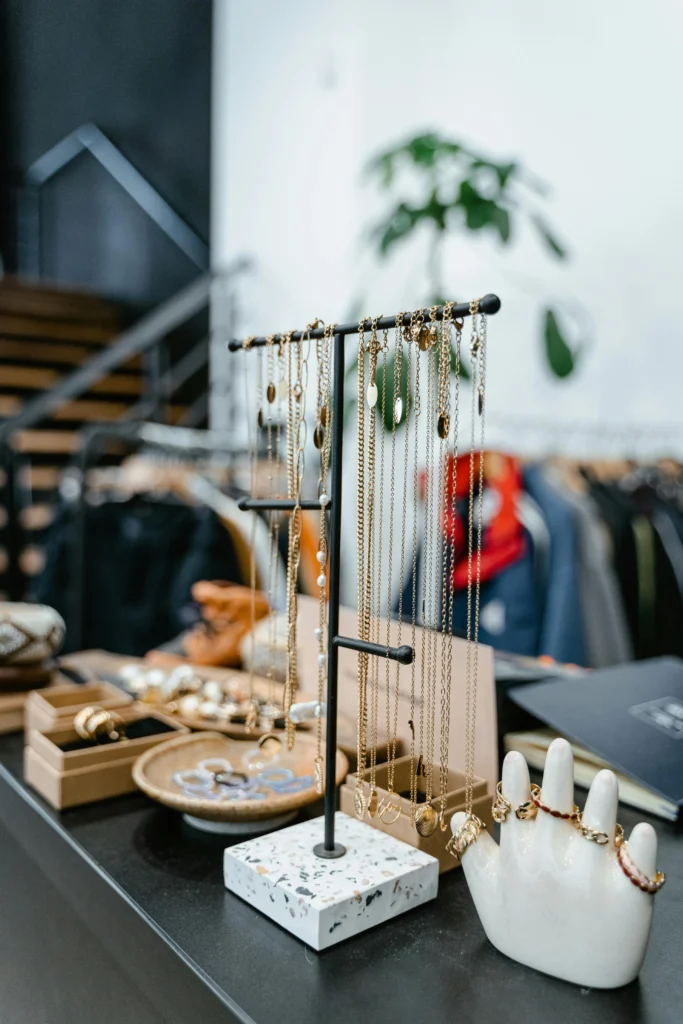
2. Customized Leather Goods
Leather wallets, belts, and bags stand out for their durability and appeal to people who value long-lasting items.
Why it works: Customization (like initials or logos) makes leather goods personal and worth premium pricing.
Steps to start:
- Learn basic leatherworking through online courses.
- Invest in hand tools (stitching awl, punches, cutting mats).
- Create small products (keychains, wallets) before scaling.
- Offer personalization through stamping or laser engraving.
Challenges & solutions:
- Challenge: Higher upfront investment.
- Solution: Start with small, lower-cost items before moving into large bags.
Startup costs: $500–$2,000.
Monetization: Direct sales, corporate gifts, premium online store.
Case example: A father-son team began making leather journals for travelers. They now sell to coffee shops and bookstores.
3. Eco-Friendly Candles
Hand-poured soy candles have gained popularity as eco-conscious consumers look for sustainable options.
Why it works: People enjoy candles for self-care, decor, and gifting. Eco-friendly positioning makes them stand out.
Steps to start:
- Learn basic candle-making (soy wax, wicks, essential oils).
- Test different scents and packaging.
- Design eco-friendly branding (recyclable jars, kraft labels).
- Sell through farmer’s markets, Etsy, or subscription boxes.
Challenges & solutions:
- Challenge: Scent consistency.
- Solution: Keep detailed notes during testing and stick to reliable suppliers.
Startup costs: $200–$700.
Monetization: Product sales, gift bundles, branded collaborations.
Case example: A stay-at-home parent started with a $300 kit. Today, their candles are featured in local wellness shops.Case example: A stay-at-home parent started with a $300 kit. Today, their candles are featured in local wellness shops.
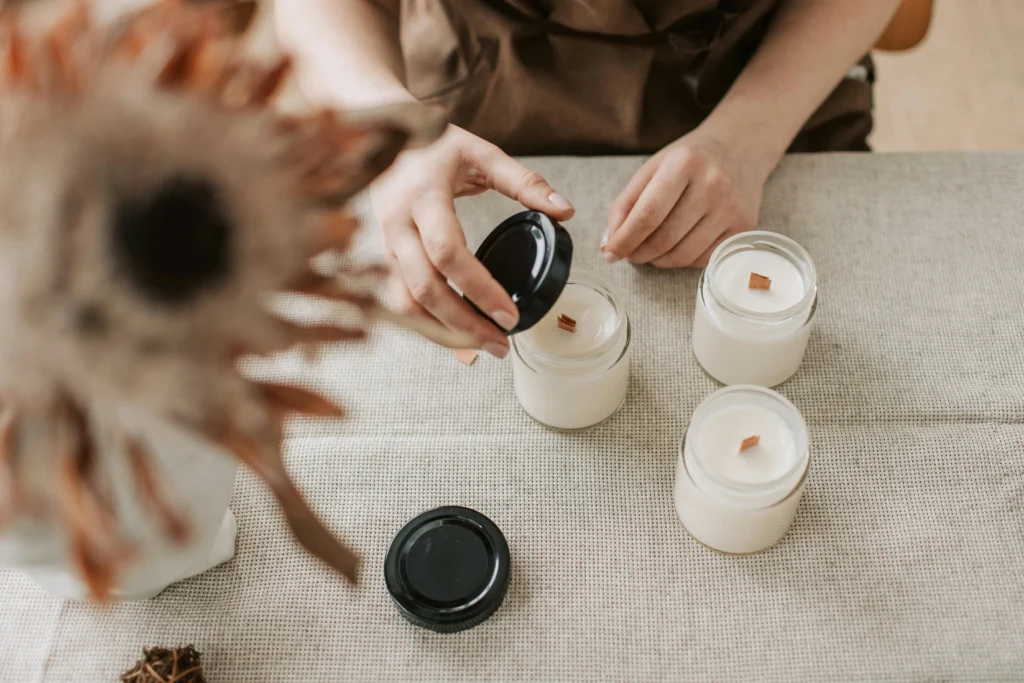
4. Woodworking Creations
Why it works: Handmade wooden furniture, cutting boards, or decor items combine functionality with timeless style. Many buyers prefer solid, handcrafted pieces over mass-produced alternatives.
Steps to start:
- Pick a niche (kitchenware, furniture, or small decor).
- Gather essential tools (saws, sanders, chisels).
- Use reclaimed wood for eco-conscious appeal.
- Sell at local markets or through Instagram shops.
Challenges & solutions:
- Challenge: High material cost.
- Solution: Start with small products like wooden coasters before scaling to furniture.
Startup costs: $500–$3,000 depending on tools.
Monetization: Direct sales, custom commissions, premium furniture orders.
Case example: A retiree started making birdhouses and expanded into outdoor furniture for neighbors.
5. Pottery and Ceramics
Why it works: Pottery serves both artistic and practical purposes (mugs, bowls, planters). Customers love owning functional art.
Steps to start:
- Learn wheel throwing or hand-building.
- Rent space at a community pottery studio if equipment is costly.
- Experiment with glazes for unique finishes.
- Sell at artisan markets or online.
Challenges & solutions:
- Challenge: Fragility of shipping.
- Solution: Focus on local markets or invest in sturdy packaging.
Startup costs: $300–$5,000 (kiln and wheel are largest expenses).
Monetization: Functional items, custom orders, pottery workshops.
Case example: A student began selling handmade mugs in campus fairs and later opened a small online shop.
6. Handwoven Textiles
Why it works: Scarves, rugs, and wall hangings made by hand have a tactile appeal machine-made items lack.
Steps to start:
- Learn basic weaving techniques.
- Use a small loom to start.
- Source natural fibers for eco-friendly branding.
- Promote as luxury or one-of-a-kind items.
Challenges & solutions:
- Challenge: Time-intensive process.
- Solution: Position as premium-priced goods to reflect labor.
Startup costs: $200–$1,500.
Monetization: Direct sales, interior design collaborations, online workshops.
Case example: A young artisan partnered with a boutique hotel to supply custom handwoven blankets.
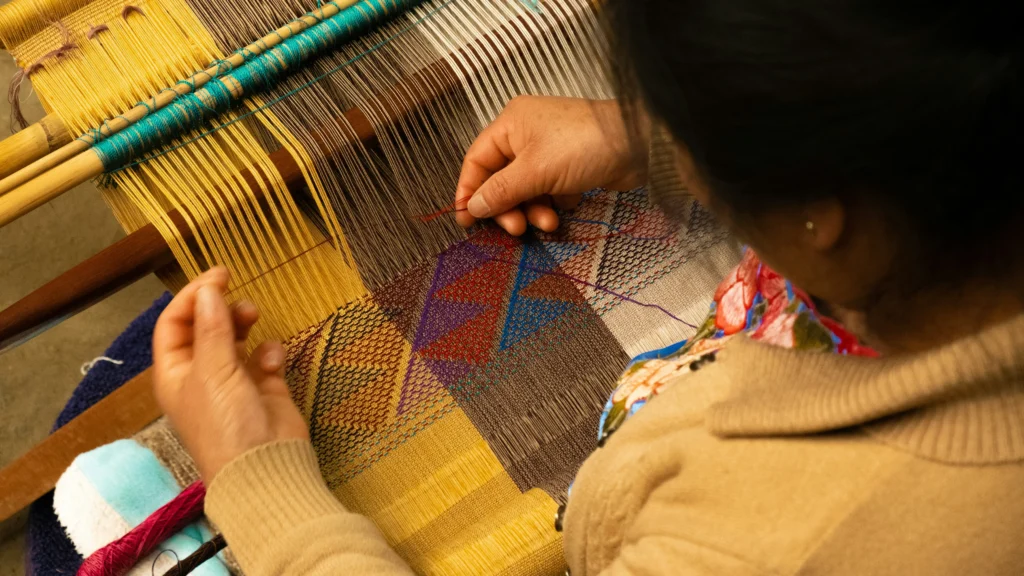
7. Upcycled Furniture
Why it works: Sustainability is trending, and customers appreciate stylish yet eco-conscious designs.
Steps to start:
- Source old furniture from thrift stores.
- Sand, paint, and repair to give new life.
- Take high-quality before-and-after photos for social media.
- Offer delivery within your city.
Challenges & solutions:
- Challenge: Limited space for storage.
- Solution: Work on one piece at a time until sales increase.
Startup costs: $200–$1,000.
Monetization: Sales via Facebook Marketplace, Etsy (local delivery), or craft fairs.
Case example: A couple refinished old chairs as a side hustle and quickly built a reputation for quality.
8. Artisan Soap and Skincare
Why it works: Handmade soaps, balms, and scrubs appeal to those seeking natural, chemical-free options.
Steps to start:
- Learn cold or hot process soap-making.
- Use natural oils, herbs, and essential oils.
- Create unique branding (scents inspired by seasons, places).
- Sell at farmer’s markets and online.
Challenges & solutions:
- Challenge: Compliance with skincare regulations.
- Solution: Research local guidelines before selling.
Startup costs: $150–$800.
Monetization: Product sales, gift sets, subscription boxes.
Case example: A crafter started selling lavender soaps and now supplies wedding favors.
9. Local Basket Weaving
Why it works: Baskets are both decorative and functional, with cultural and artisanal value.
Steps to start:
- Learn weaving with cane, straw, or recycled materials.
- Start with small baskets for household use.
- Market to eco-conscious and bohemian-style buyers.
- Attend local artisan fairs.
Challenges & solutions:
- Challenge: Time-consuming production.
- Solution: Focus on limited-edition or custom designs.
Startup costs: $100–$500.
Monetization: Direct sales, decor boutiques, online eco-stores.
Case example: A grandmother taught her weaving skills to her granddaughter, who now runs a small online shop.

10. Calligraphy and Hand-Lettering
Why it works: Personalized calligraphy is in demand for weddings, events, and decor.
Steps to start:
- Practice with calligraphy pens and digital tools.
- Offer services for wedding invitations or business branding.
- Sell digital prints on Etsy.
Challenges & solutions:
- Challenge: Scaling services.
- Solution: Create printable designs for passive income.
Startup costs: $50–$300.
Monetization: Custom services, workshops, digital downloads.
Case example: A side hobby of hand-lettering quotes turned into a profitable Etsy shop.
11. Embroidery and Needlecraft
Why it works: Embroidery combines tradition with modern creativity (custom clothes, wall art, patches).
Steps to start:
- Choose fabrics and threads.
- Start with small projects like patches.
- Sell on Instagram or collaborate with clothing brands.
Challenges & solutions:
- Challenge: Slow process.
- Solution: Offer high-end personalization rather than mass production.
Startup costs: $50–$200.
Monetization: Direct sales, fashion collaborations, workshops.
Case example: An artist stitched custom denim jackets and built a loyal following.
12. Glass Art and Stained Glass
Why it works: Stained glass pieces, suncatchers, or fused glass jewelry stand out as unique decor.
Steps to start:
- Learn glass cutting and soldering.
- Start with small suncatchers.
- Promote with photos showing light reflections.
Challenges & solutions:
- Challenge: Fragility.
- Solution: Market as local pickup or use secure shipping.
Startup costs: $300–$2,000.
Monetization: Custom commissions, online sales, art exhibitions.
Case example: A local glass artist supplies handmade panels for cafes and homes.
13. Handmade Musical Instruments
Why it works: Unique instruments like kalimbas, flutes, or hand drums appeal to musicians and collectors.
Steps to start:
- Learn traditional crafting methods.
- Start with small, simple instruments.
- Collaborate with local musicians for exposure.
Challenges & solutions:
- Challenge: Technical skill required.
- Solution: Focus on one instrument type until mastery.
Startup costs: $300–$1,500.
Monetization: Direct sales, workshops, partnerships with music schools.
Case example: A hobbyist drum maker now sells to local festivals.
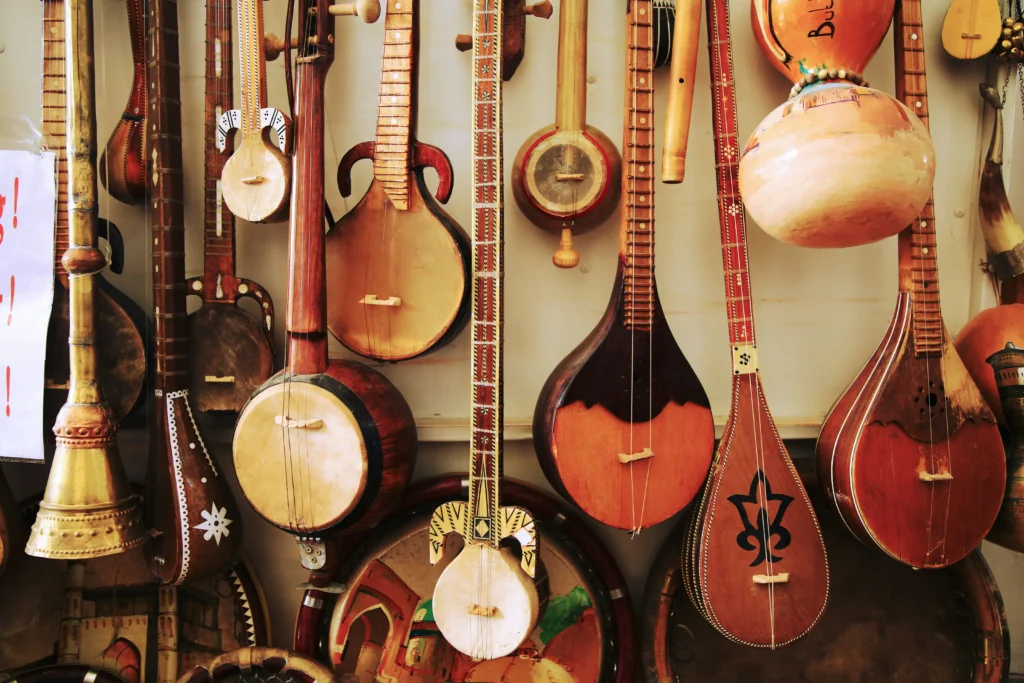
14. Knitting and Crocheted Goods
Why it works: Cozy, handmade clothing and blankets are always in demand during colder seasons.
Steps to start:
- Master basic stitches.
- Start with accessories like hats or scarves.
- Use eco-friendly yarn for added appeal.
Challenges & solutions:
- Challenge: Competition from mass-produced items.
- Solution: Highlight handmade uniqueness and sustainable materials.
Startup costs: $50–$300.
Monetization: Direct sales, pattern downloads, knitting classes.
Case example: A crafter’s chunky blankets became popular through Instagram marketing.
15. Beekeeping Products (Wax Crafts, Candles)
Why it works: Beekeeping by-products like beeswax can be turned into profitable crafts.
Steps to start:
- Learn basic beekeeping.
- Harvest beeswax to make candles or wraps.
- Sell locally with eco-friendly branding.
Challenges & solutions:
- Challenge: Beekeeping requires space.
- Solution: Partner with local farms if you lack land.
Startup costs: $500–$2,000.
Monetization: Honey, wax candles, eco wraps, workshops.
Case example: A beekeeper sells beeswax wraps at eco-markets alongside honey.
16. Paper Craft and Origami Art
Why it works: Handmade cards, origami decor, and paper flowers are affordable yet artistic.
Steps to start:
- Invest in quality papers and cutting tools.
- Start with greeting cards or framed origami.
- Market as unique gifts or decor.
Challenges & solutions:
- Challenge: Low margins.
- Solution: Create premium sets or custom event decor.
Startup costs: $50–$200.
Monetization: Product sales, workshops, event collaborations.
Case example: A teacher sells origami flower bouquets for weddings.
17. Handmade Toys and Dolls
Why it works: Parents often seek safe, non-toxic, and unique toys for children.
Steps to start:
- Learn basic sewing or woodworking.
- Focus on safe, child-friendly materials.
- Sell through parenting groups or fairs.
Challenges & solutions:
- Challenge: Safety standards.
- Solution: Research certifications required for children’s products.
Startup costs: $100–$500.
Monetization: Direct sales, gift shops, custom doll commissions.
Case example: A mom started sewing rag dolls and built a steady Etsy business.
18. Artisan Food Packaging (Gift Baskets, Boxes)
Why it works: Packaging is just as important as the food itself. Artisan baskets and boxes create memorable experiences.
Steps to start:
- Source local goods (jams, teas, cookies).
- Create themed baskets (holiday, wellness, local flavors).
- Market as corporate gifts or event packages.
Challenges & solutions:
- Challenge: Coordinating multiple products.
- Solution: Partner with local artisans for bulk supply.
Startup costs: $200–$800.
Monetization: Direct sales, seasonal promotions, corporate partnerships.
Case example: A small business curates “local flavor” boxes for tourists and companies.
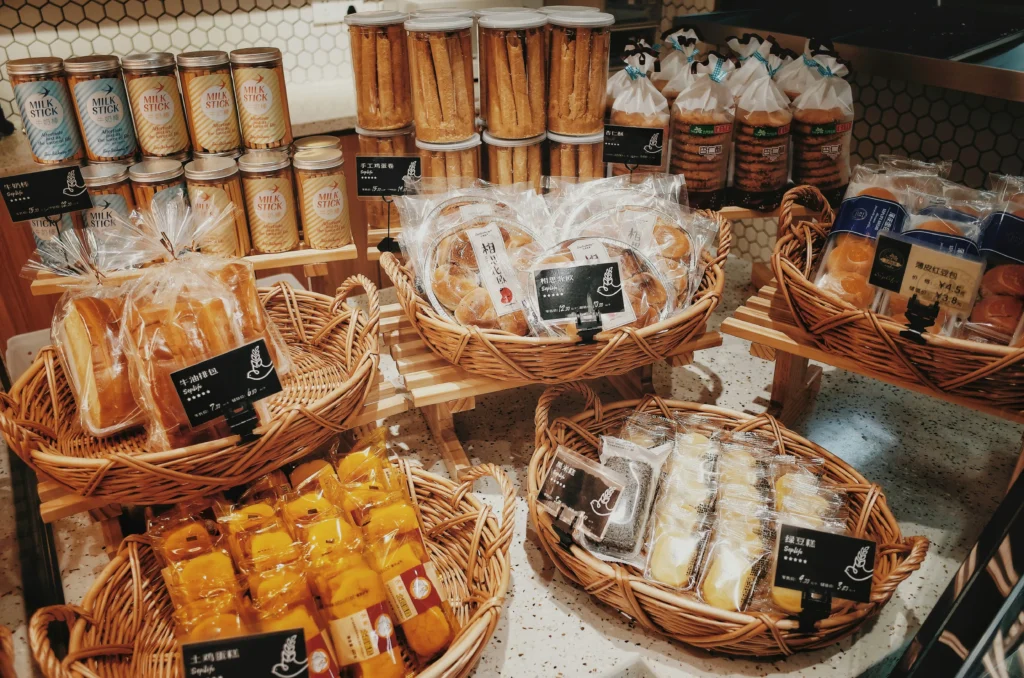
19. Stone Carving and Sculpture
Why it works: Hand-carved stone items (statues, decor, jewelry) are rare and valued for durability.
Steps to start:
- Learn carving techniques with soft stones like soapstone.
- Create small figurines or pendants before scaling.
- Market to art collectors or garden enthusiasts.
Challenges & solutions:
- Challenge: Labor-intensive and tool-heavy.
- Solution: Start with smaller, manageable projects.
Startup costs: $300–$1,500.
Monetization: Direct sales, gallery exhibitions, commissions.
Case example: A sculptor began selling small carved pendants before moving to larger statues.
20. Metalworking and Blacksmith Crafts
Why it works: Handmade metal goods like knives, jewelry, or decor combine durability with artistry.
Steps to start:
- Learn basic forging or welding.
- Invest in a small forge or workshop space.
- Start with small items like bottle openers or rings.
Challenges & solutions:
- Challenge: Expensive tools.
- Solution: Use shared maker spaces before investing heavily.
Startup costs: $500–$5,000.
Monetization: Direct sales, workshops, custom commissions.
Case example: A blacksmith sells handmade kitchen knives at farmer’s markets.
21. Seasonal Artisan Goods (Holiday Markets)
Why it works: Seasonal crafts (Christmas ornaments, Easter baskets, Halloween decor) generate high demand.
Steps to start:
- Pick one holiday to specialize in.
- Create themed products (ornaments, wreaths, candles).
- Sell at seasonal fairs and online months before the event.
Challenges & solutions:
- Challenge: Limited sales season.
- Solution: Rotate through multiple holidays.
Startup costs: $100–$500.
Monetization: Holiday fairs, online shops, custom event decor.
Case example: A crafter sells handmade ornaments during Christmas and pivots to Valentine’s gifts afterward.
The artisan crafts industry is proof that creativity and business can go hand in hand. From handmade jewelry to upcycled furniture, each idea we explored shows that with time, effort, and patience, it’s possible to create something meaningful and profitable.
If you’re just starting out, don’t feel pressured to pick the “perfect” idea right away. Try one, learn from the process, and see what resonates with both you and your audience. Remember, every journey starts small.
I encourage you to explore other niche guides here on Nichejar.com, leave a comment with your thoughts, or share this with someone who might find it useful. I believe that with persistence and humility, you can carve out your own path in the artisan crafts world.
TLDR
In short:
- Handmade jewelry – Low startup costs, big audience.
- Customized leather goods – Premium market, personalization.
- Eco-friendly candles – Growing demand in self-care and sustainability.
- Woodworking creations – High-value items, local markets.
- Pottery and ceramics – Unique, functional art.
- Artisan soaps/skincare – Everyday need with a creative twist.
- Upcycled furniture – Eco-conscious buyers love this.
